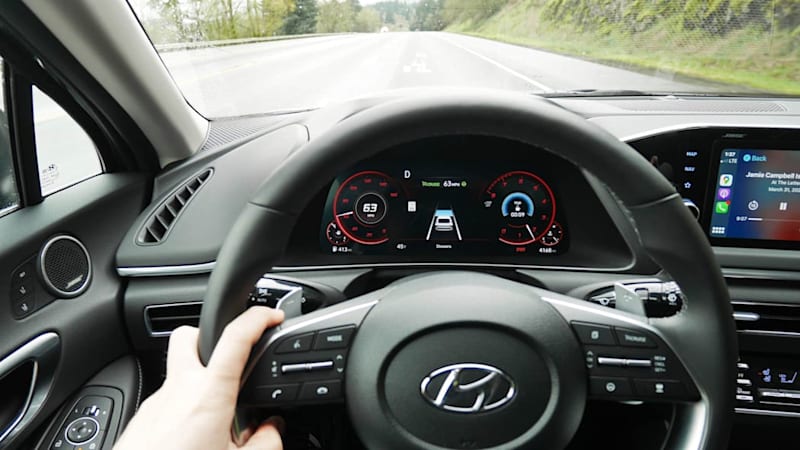There are numerous driving assistants and semi-autonomous systems available on cars today. Some are excellent, while others can be downright annoying. You can judge them by a range of qualities, but one of the best ways to judge the usefulness of a Driving Assist is to see how well it can keep the car in the middle of its lane. That’s one specific area in which Kia’s Highway Driving Assist excels – the same can be said for many Hyundai and Genesis models with the same system on board.
Full-featured driving assistants are old news for many luxury brands. Mercedes-Benz, BMW, Volvo and others have been offering such systems for years – the Mercedes and BMW even change lanes for you at the touch of a button. And of course, no conversation about driver assistance systems would be complete without the mention of Tesla. However, today we’re going to talk about the system found in the 2021 Kia K5 GT that we recently tested.
What’s surprising here is how excellent the Highway Driving Assist system is. It reads the way ahead of you via a front camera and a front radar. In addition, it uses information from the navigation system to ensure that the system is used on a “highway or highway”. If you are not on an approved road, it will not fully activate. You can also rely on the system to automatically set the cruise control to the speed limit of the road, assuming you are traveling exactly at the specified speed.
The system is designed to be a complete assistant on the highway at the touch of a button on the steering wheel. It is capable of adaptive cruise control at full speed and remains active in stop and go traffic. In addition, it controls the steering to keep the car in the center of the lane at all speeds. This second part (lane-keeping) is just as masterfully executed as the smart Mercedes-Benz Active Steering Assist.

We took a multi-hour highway cruise on a number of different types of highways, and it required a shockingly small amount of intervention with the Highway Driving Assist engaged. The car would follow perfectly in the center on straights, soft corners and even some tighter corners. Most notably, it goes further than where most lane centering systems would give up when cornering. Some lane centering assistants will whine just as much as they help by accidentally pulling the steering wheel or by randomly losing sight of the lines. That rarely happens here, as it helps without getting annoyed for hours on end. Poorly executed driver assistants need your constant attention to make sure they are working properly – there is no added stress with this Kia. Instead, it successfully reduces stress on the highway – you’ll be surprised how much fresher you feel at the end of a ride if you just keep an eye on the accelerator, brake and steering instead of operating them.
This next point is worth discussing, but the length of time between necessary steering wheel touches is also on the long side. To experiment, we could set it up and forget it for almost a minute before the system would remind us to put our hands back on the wheel. And even then, a quick little tug resets it for a new period. Of course, Hyundai doesn’t call this a hands-free system and we recommend that you keep your hands on the wheel and be ready to take over. We were only testing the parameters of the system.

The car’s ability to track so well over such long periods of time is what’s really remarkable here. Just as Mercedes’ system feels like it can travel endlessly without intervention, this Highway Driving Assist feels the same. Really, the only things that could make it trip were infrastructure failures where the lane markings disappeared or nearly faded. Even then it showed no bad or unwanted maneuvers. The K5 didn’t lose a beat when driving at night either, and past experiences with a Hyundai Palisade have shown that persistent rain on a winding mountain road didn’t confuse the system either.
The only thing that the Kias and Hyundais cannot (which others, such as Mercedes-Benz, BMW and Tesla can), is automatically changing lanes. You need to buy a Genesis with the “Highway Driving Assist II” system to get that functionality – the G80 and GV80 also use a new adaptive cruise machine learning program that adjusts its behavior to suit your driving style. However, automatically changing lanes with the tap of a turn signal lever is more of a gimmick than a legitimately useful feature, so Kia and Hyundai that don’t have it yet isn’t a big deal.
Unsurprisingly, the adaptive stop-and-go cruise control also worked like a dream. It is properly tuned and responds to changes in traffic conditions within an acceptable time. There are no fancy driving visualizers like you’d find in a BMW, Tesla or those new Genesis models that animate the cars around you in a forward screen, but those features are really just a source of intrigue or distraction.
The best thing about this whole system is that it is available on affordable vehicles. Highway Driving Assist can be added to the Kia K5 (our test car), Kia Telluride, Kia Sorento, Kia Carnival, Hyundai Palisade, Hyundai Sonata, Hyundai Elantra, Hyundai Santa Fe, Hyundai Ioniq, Hyundai Tucson, Genesis G80, Genesis GV80 and Genesis G90. Very few non-luxury vehicles offer anything remotely equivalent to the capabilities of Highway Driving Assist – Nissan’s latest ProPilot Assist comes the closest in terms of capability and availability. To get something similar or better, you have to pony up for a much more expensive luxury car. It also serves as a new triumph in safety engineering from Hyundai Motor Group, which received the Autoblog Technology of the Year award in 2020 for its outstanding blind spot monitoring technology.
Related video:
